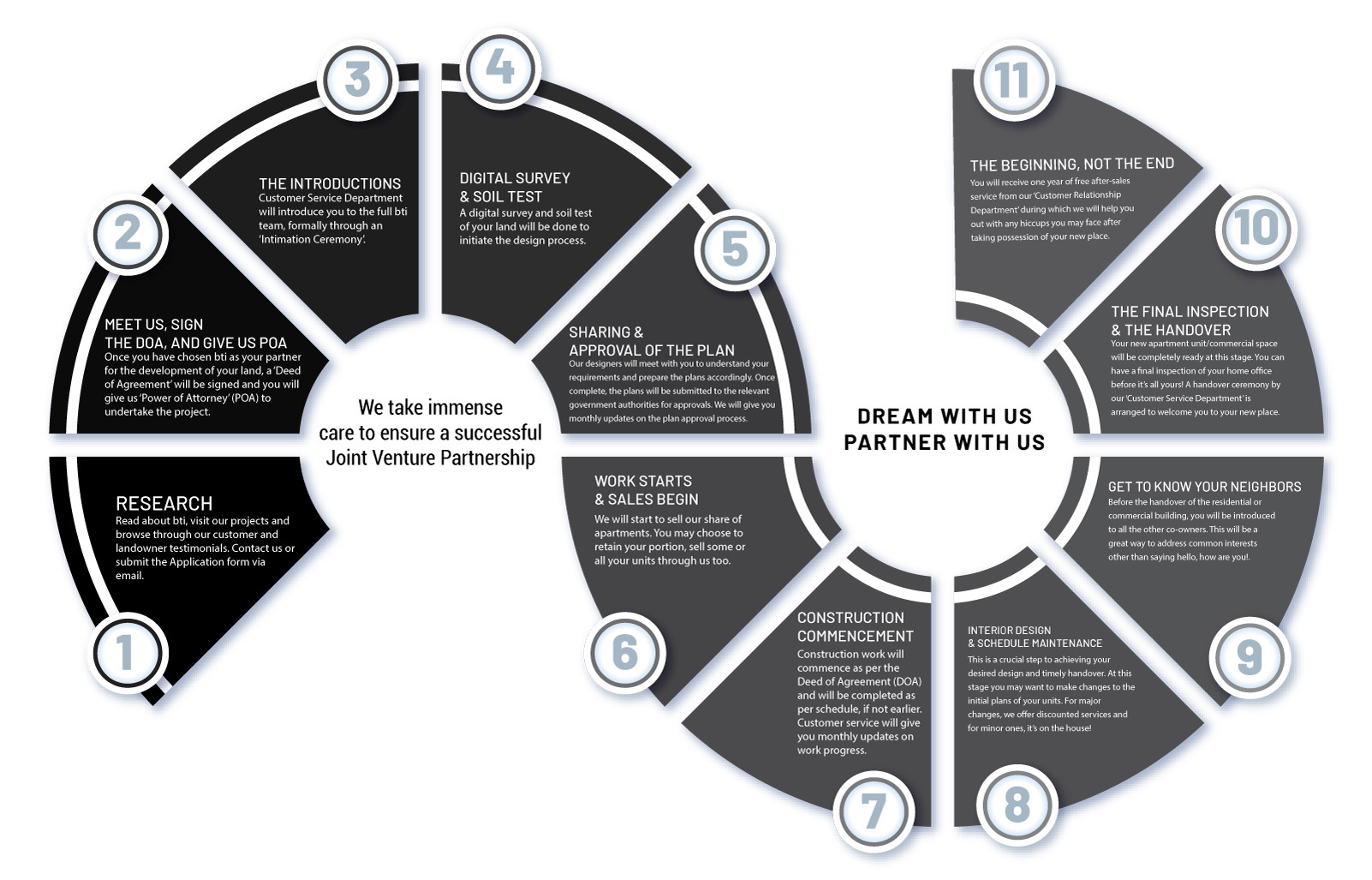
Why Choose bti as a Partner TO DEVELOP YOUR LAND?
Dealing with real estate developers in Bangladesh is often complex and risky which does not have to be. Though the joint venture process, to date, remains bureaucratic and difficult, we have made it easier and hassle-free. We believe no one else can offer the same level of expertise as us and our landowners who have partnered with us, think so too. Read about their experience with us and take a look at some of our finished projects
HOW IS BTI DIFFERENT?
bti is one of the few companies known for being trustworthy as a joint venture partner for developing your land. As one of the pioneers in the sector, we have retained our position as a top real estate developer and have built this reputation of reliability over the good part of half a century.
We fully understand your dilemma and know how to tackle the complex systems involved in developing your property. Our vast experience has left us in a better position than most, to empathize and take care of all your concerns regarding the big decision to develop your land.
With a specialized customer service team along with architects, engineers, and logistic support, we work to make the process stress-free for you and continue to be at your service for years to come. Find out more about us and what makes us different.
What Is the Process of Joint Venture Partnership?
WANT TO KNOW MORE?
We have been doing this for more than 40 years. Construction is our business along with ensuring full satisfaction of our customers and business partners. Don’t just take our word for it. You can read some of the comments of the landowners for whom we have developed properties over the years. You can also see the projects we have completed so far as seeing is believing. Entrust us as your joint venture partner. Be a part of bti, the leading real estate developer in Bangladesh.
FAQs - for your benefit
Q: What does DAP mean?
DAP means Detail Area Planning. The general objectives of DAP are to implement the provisions of the DMDP Structure Plan (SP) and Urban Area Plan (UAP) policies and recommendations.
Q: What is FAR?
The floor area ratio (FAR) is the ratio of a building’s total floor area (gross floor area) to the size of the piece of land upon which it is built. It is often used as one of the regulations in city planning along with the building-to-land ratio. The terms can also refer to limits imposed on such a ratio through zoning.
Written as a formula, FAR = gross floor (building) area ÷ area of the plot
Q: What affects FAR and what would be the maximum construction area of a building?
The maximum ground coverage (MGC) depends on the land size and the width of the road at the entrance. The front road width also affects the FAR values. In short, the square feet/ square meter multiplied with FAR value will result in the maximum construction area of a building. As a rule of thumb, FAR is 3.75 for a 5 Katha plot with a 25′ wide front road. Hence, the maximum ground coverage (MGC) will be 62.50% which would be 13,837 sft as the total construction area with verandahs.
Q: How many parking spaces will be available for any building?
The number of parking spaces depends on land size, land shape, building height, basement provision, car lift, park lift, etc. This is determined on a case-by-case basis. As an example, a 5 Katha plot may have 8-9 car parking spots, depending on various factors.
Q: What needs to be considered for basement floor construction?
The basement floor construction is generally expensive and unless constructed with care, there can be water leakage and dampness. For smaller plots of land below 8 Katha, basements are not generally feasible. However, for larger plots of land requiring a large number of parking spots, basements become a necessity.
Q: What is space sharing?
Space sharing refers to the use of space in a building by the Landowner and the Developer. In a joint venture development, space sharing depends on a mutual understanding between the Developer and the Landowner. There is no fixed formula for this and it depends on the land value, selling price of the property, the number of apartment units, and the agreed signing money.
Q: How is the distribution of floors done?
Floor distribution is done through mutual understanding between Landowner and Developer. Both Landowners and Developers choose the floors as per the merit or value of the property.
Q: How is the size of the apartment measured?
The size of the apartment is the net floor area of the apartment plus the common areas as specified in the Real Estate Management Act 2010.
Q: Which areas are considered as common space?
As per the Real Estate Management Act 2010, spaces such as lift-lobby, staircase room, lift machine room, generator room, sub-station room, caretaker’s room, guard room, and other common facilities like gym space, prayer room, library room, guest waiting area, reception area, etc. are considered as common space.
Q: What are the considerations for getting approval of the plan?
In Dhaka, RAJUK and Cantonment board is the final authority for approval of plans and in Chattogram, it is CDA. Plan approval depends on various factors such as building height, whether it is a regular or special project, number of apartments, road-width, the permission of concerned authorities (Civil aviation, traffic, DMP, environment, etc.), conditions of the township planning department, whether it is a leasehold property or freehold property, land status, etc.
Q: How is fire protection ensured in buildings?
Fire protection in an apartment building is ensured through the availability of essential firefighting tools such as fire extinguishers, fire hydrants, sprinklers, etc. Having a fire staircase is mandatory as per BNBC rules.
Q: What measures do you take to make buildings earthquake-resistant?
bti follows the BNBC code for earthquake protection. Beyond implementing BNBC code, bti is the only developer who has introduced the jacketing system, which is a scientifically proven method for an earthquake-resistant design.
Q: Do you test the materials or concrete strength?
bti carries out appropriate testing to ensure all the materials used are of the highest quality. We test certain materials like steel bars and the strength of concrete from BUET.
Q: When will you take the possession/handover for construction work?
Possession/handover is subject to a mutual understanding between the Developer and Landowner, once again. Generally, the possession for starting construction is required after the plan has been approved by the concerned authority.
Q: How does bti ensure its quality of construction?
bti follows all the rules and guidelines, uses materials of the highest quality, and goes beyond that by implementing technology making buildings more earthquake-resistant than others. All these factors ensure that your building is a haven with superior construction quality. We also arrange for our customers to visit the site during construction to see the quality of construction for themselves. Immense emphasis is placed not only on the construction, choice of materials and also on details.
Q: How would you form the 'Owners' Association' after handover?
Upon completion of the project, we arrange a meeting of all the owners of the built property to form an Association and an ad hoc Committee and provide them with a set of by-laws. The Committee subsequently arranges an election to appoint the office bearers of the Association. The Owners’ Association is responsible for the maintenance of the building and its regular monetary accounts.
Q: What is your maintenance service policy?
bti provides a 1-year free after-sales service to the apartment owners for maintenance and the upkeep of apartments.
